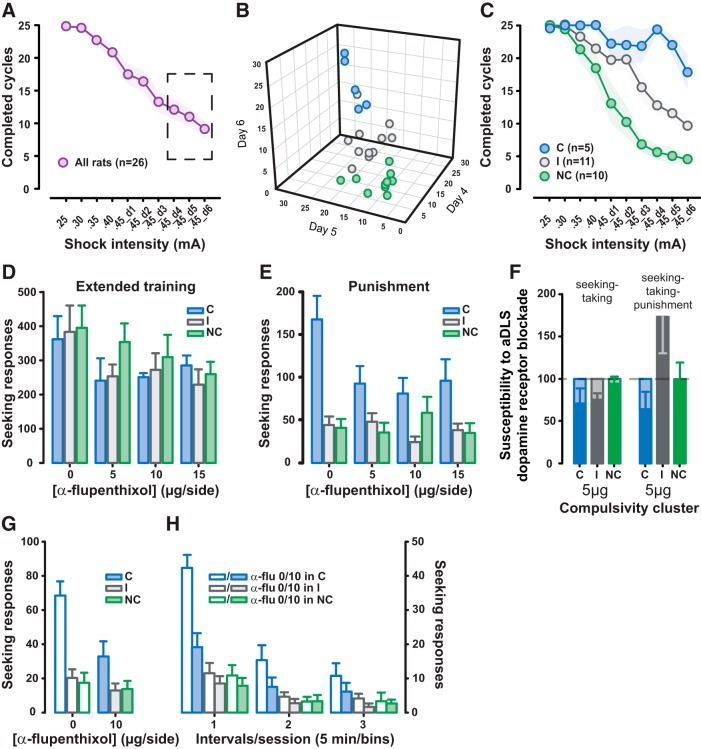Figure 3.
Compulsive alcohol seeking is mediated by aDLS dopamine-dependent mechanisms. A, Introduction of unpredictable punishment of seeking responses (footshock intensity increasing from 0.25 to 0.45 mA) over repeated sessions resulted in decreased alcohol-seeking responses in the entire population of rats (n = 26) as revealed by the magnitude and time-dependent decrease in the number of completed seeking–taking cycles per 2 h session. B, C, However, marked interindividual differences in the response to punishment of seeking responses were revealed by a cluster analysis performed on the completed cycles during the last three sessions of punishment (in the dashed-line rectangle) in that 5 rats resisted punishment and were deemed C (blue dots), 15 rats were sensitive to punishment and were deemed NC (green dots), and 11 rats displayed intermediate sensitivity to punishment (I; gray dots). D, E, While seeking responses after extended training were, at the population level, dose-dependently decreased by bilateral aDLS infusions of the dopamine receptor antagonist α-flupenthixol (0, 5, 10, or 15 μg/side) in all of the rats regardless of their compulsive phenotype (C rats in blue, I rats in gray, and NC rats in green; D), only C rats displayed a susceptibility to aDLS dopamine receptor blockade when instrumental seeking responses were performed under the threat of punishment (E). F, The selective effect of aDLS dopamine receptor blockade in C rats cannot be attributable to rate dependency, as demonstrated by the lack of difference in the effect of the otherwise effective dose of 5 μg/side α-flupenthixol infusion on the normalized seeking responses of C rats (n = 5; blue) tested under the seeking–taking task (on the left) and under the seeking–taking–punishment task (on the right), compared with I rats (n = 11; gray) and NC rats (n = 15; green). G, H, The differential susceptibility to aDLS dopamine receptor blockade that emerged in C rats under punishment persisted after its cessation, in that only C rats maintained alcohol-seeking responses that were susceptible to bilateral aDLS α-flupenthixol (10 μg/side) infusions measured over 15 min extinction sessions that followed several nonpunished baseline sessions (G), with the differences among C rats (n = 5; blue), I rats (n = 11; gray), and NC rats (n = 15; green) being observable at each 5 min block of the extinction session (H). Graphs show mean ± SEM values.

